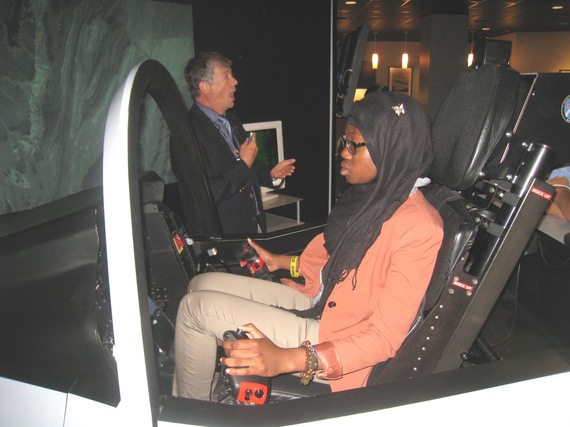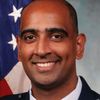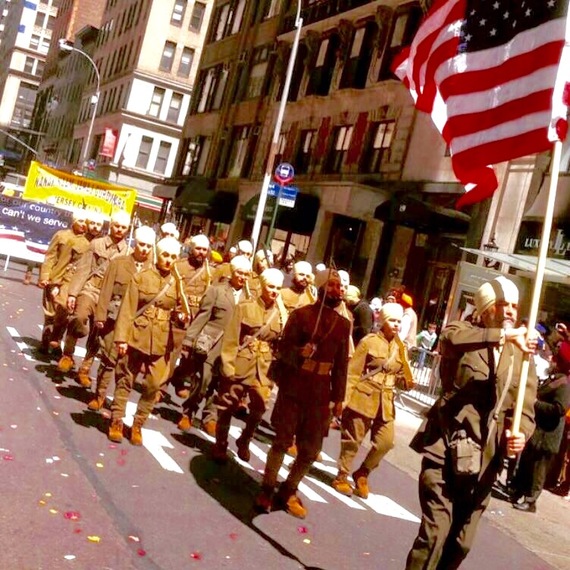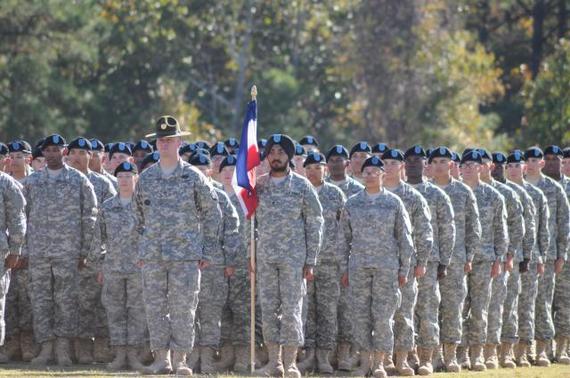This spring, Sikh Soldiers serving in the United States Military re-enacted a historic regiment and marched in New York City at the annual Sikh parade. Their right to march was made possible by our founders, who envisioned a republic where the voice of a minority could be heard and tyranny at the hands of a majority would not marginalize members of the citizenry. Most importantly, their march came at a time when the U.S. and the rest of the world finds itself locked in a bitter struggle against violent extremism. With their symbolic march, the regiment offers an important introspective for Pentagon leadership, and an opportunity to sharpen its strategy against extremism in the same way our founding fathers once fought oppression -- with the power of American ideals.
Deconstructing Extremist Ideology: The Art of the Long Game
Extremist ideologues, the kind that threaten global security, feed on oppression, intolerance, misogyny, and homogeneity. In the information age, their subversive tactics are amplified by the media environment and the unintended collateral consequences created by fighting them through kinetic means. The end result is an ideological factory for new extremists. In a speech at the Hoover Institute in 2010, the Chairman of the Joint Chiefs of Staff, Admiral Mike Mullen, emphatically lamented our current tactics and unveiled the need to develop new philosophical frameworks for dealing with extremism. Little did we know the ideological solution might reside within our very own battle formation. After all, the best way to fight ideology, is with ideology.
As such, the Pentagon can gain much from ongoing efforts to grant Sikhs the unrestricted right to wear their turbans in formation as the British, Canadian, and Australian militaries have already done. Not because it is the right thing to do, but because of all things it would hurt the extremists in the deepest manner possible. While kinetic operations against extremists are a foregone conclusion, the framework for fighting extremist ideology is far more fundamental, and involves the qualities we espouse as Americans. When it comes to extremist ideology, E' Pluribus Unum ought to be the weapon of choice.
What better place to unveil this strategy than in our current ranks. In the Sikh tradition, the turban is a symbol of equality, freedom, and liberty. Yet, naysayers claim that the requirement to preserve homogeneity and standardization in the ranks is too important to "good order and discipline" to compromise. Ironically, this was the same justification made when our government denied African-Americans, women, and members of the LGBT community from claiming their rightful place in the battle formation. In my opinion, more visible inclusion of Sikh and other minority cultures into our ranks is too important of an opportunity to miss. In the U.S., the Asian American population has doubled in the past decade and is the fastest growing demographic in our nation. It is time to reflect this changing dynamic in our military ranks with real policy changes.
Changing Paradigms of a Bygone Era
In some ways, it is as if we've forgotten that we were born of a disparate militia, cobbled together from hand-made muskets, fur skin hats, and unique back-country dress. Our founders knew that our diverse formations carried both a tactical and ideological advantage when confronting our enemies. It's time to look ourselves in the mirror and ask ourselves, have we become the pretentious and plump red coats, bearing the signature white "X" on our backs and ready to impress the world with our homogeneity?
It is time for the Pentagon to remind itself that there can be no greater dagger into the heart of extremist ideology than to have extremists see all the world's cultures visibly marching in one formation -- black, white, brown, turbans, LGBT, men, women, yarmulkes, tribal tattoos, and the like; all standing in the ranks together and united against intolerance and hate. For some in the Pentagon leadership, the sight would be an abomination. To me, it would be... well, as American as the Minutemen.
In my career, I have deployed and served alongside Tongans, Chinese, Buddhists, Indians, Irish, Germans, Men, Women, LGBT, Hindus, Atheists, Japanese, Christians, Jews, and Muslims alike. We brought our cultures to the combat zone with a chip on our shoulders and served with an undying unity of purpose. We weren't colorblind, we were colorful. Yet we weren't always allowed to show it in formation. There were too many rules designed to preserve "good order and discipline." In actuality I wish we could have brought more of our cultures to the formation so our enemies could see us every day, visibly postured against xenophobic and misogynistic ideology. Yet, the policies and more importantly a culture of xenophobic cronyism in our military wouldn't allow it. If you ask me, that's strange for any American to digest. But that is reality for minorities serving in the military.
So why the seemingly mundane detour from ISIS strategy to diversity? Hang on, we're getting there.
Misguided at the Top
Diluted by official buzzwords and recruiting slogans that give the appearance of action, the Department of Defense has sequestered bonafide issues of justice and equality into weak programs that many of its senior leaders neither believe in nor take seriously. The few that do, find themselves isolated, then gone.
I have grown to respect the resiliency of the Department of Defense and individual Service Assistant Secretaries appointed to support diversity and inclusion within the military. However, I don't envy the daily challenges they face. The reality is that they are treated primarily as figureheads, red herrings placed to avert real investments in diversity and inclusion programs. Their staffs are often under-resourced, undermanned, and outgunned by the xenophobic cronyism of the permanent Pentagon elite. Senior diversity leaders and their staffs are shuffled off to conferences and working groups where they mostly talk to themselves, and ultimately receive kind smiles from the Pentagon establishment when they bring their reforms back for action.
The Pentagon regularly tries to demonstrate they are working hard at recruiting underrepresented communities. However, actions merely come off as yet another example of institutional apathy. Just take a look at any military recruiting commercial. The demographics portrayed are so overtly directed at targeted minorities, you'd think that 50 percent of fighter pilots were women, as opposed to the actual number of approximately 2 percent. The commercials conveniently buttress the facade that diversity isn't a problem that requires attention. Defined primarily as a "front end" recruiting issue, targeted recruiting of minorities has replaced genuine investments in outreach and inclusion programs, leaving recruiters frustrated with a quota system that challenges their ethics. After a recent trip to the national Women in Aviation International conference, the largest women's aviation venue ever assembled, I was left wondering, "Where is the Air Force?" A fellow aviator replied, "When it comes to inclusion, the Air Force must be operating in stealth mode."
At the Pentagon, real inclusion policies for minorities and women just never seem to advance, despite glowing memorandums from senior leaders. Just take a brief walk down the Pentagon "E-ring" where senior defense official portraits are hung. A quick look and it's not too hard to figure out. Our leaders and their leaders before them pick successors that look like themselves. Despite significant diversity campaigns, real actions paint a sobering picture for the future of innovative thinking in the military. Recruitment and retention of minorities is down and minority general officers are leaving in droves. Why? It's not diversity, it's the climate.
A Climate That Kills
Even in the wake of the Danny Chen and Harry Chu deaths (suicide deaths attributed to racially motivated hazing), leaders still can't seem to find the courage to open Pandora's box on social climate for minorities such as Asian Americans. Earlier this year, a non-profit reached out to me to provide feedback on climate for Asian Americans serving in the military to support a Department of Defense inquiry. I was referred to defense officials to provide experiences of Asian American soldiers in the field. I contacted several serving in the military to hear some of their stories and experiences.
The results defied belief.
After forwarding several egregious cases of discrimination to the Department of Defense Inspector General, I never received a call back again. Was DoD seriously hoping to hear "the good news," then close the matter? One Asian American reported that he had been the subject of horrific racial epithets, referred to regularly as "Sand N----" by fellow soldiers. In another instance, a young vegetarian soldier reported to me that he was force-fed meat by his peers, and a senior supervisor had dangled meat in front of his face. In yet another instance, an Airman in flight school was referred to psychological evaluation by an evangelical doctor for potential removal during medical screening due to his religion, and the tolerant beliefs he held.
For those choosing to utilize the military equal opportunity system, retaliation, intimidation and reprisal occurred in many of the cases. Equal opportunity investigations, influenced by a xenophobic command climate, regularly dismissed even the most egregious cases of institutional bias. Since military equal opportunity policy does not allow for "disparate" treatment consideration, discrimination cases continue to go unsubstantiated, even in clear cut cases of xenophobic behavior. A cursory review revealed a complete lack of accountability in the military equal opportunity system.
In April of 2015, Captain Gary Bhatti, an Asian American soldier serving at Fort Bragg reported that he was described as having a "likeness of ISIS" in front of his peers by his managing director. Such a humiliating verbal assault on a soldier was hard enough to fathom, let alone the fact that his chain of command concluded that he made the scenario up. In 2014, the Department's first-ever Hindu Chaplain was forced to retire amidst a barrage of bigotry and hazing from her evangelical chain of command. This cultural bleeding has to stop now.
Renewing A Strategy of American Exemplarism
Kinetic operations must continue in the fight against extremist ideology. However, our strategy needs something more. The visual power of all our people in the ranks, bringing their authentic selves to the table, must play a larger role in our strategy. The resulting optic presents a veritable pin prick through the heart of extremist ideologues, and is a precision weapon that is hard to circumvent. American exemplarism, the notion that our actions must reflect the ideals we wish others to emulate, must become the new standard in our strategy against violent extremism.
Nobody is suggesting a moral equivalency to the violent extremists that threaten global security. However, before we construct a solid philosophical strategy to combat them, we must first keep pace with the changing demographics in our nation, establish new paradigms and realize policies of a truly representative military. Most importantly, naysayers must, shall I say, adapt and "assimilate" to the reality of a more nimble strategy to undergird kinetic operations.

Ms. Mariam Cocker, from Eleanor Roosevelt High School in Maryland, takes the controls of an F-35 simulator, instructed by a Lockheed Martin Fighter Demonstration Center representative.
It was Gandhi who reminded us that we can have all the guided missiles and precision weapons in the world, but we can ill-afford to have misguided leadership. Our leaders must be exemplars in the principles of tolerance and inclusion. Most importantly, they must back it up with action. Ultimately, the turbans, tunics, and tribal tattoos that we once called a "threat to good order and discipline" will once again arm our democracy with power of our tolerance and sense of justice. Our founders once believed that these ideals were formidable enough to topple the forces of tyranny and guide our nation to freedom.
The Pentagon should too.
Ravi Chaudhary is a retired Air Force Officer, Pentagon strategist, pilot, and former recruiting commander. The opinions expressed in this article are the author's own and do not reflect the view or an official position of the United States Government.


